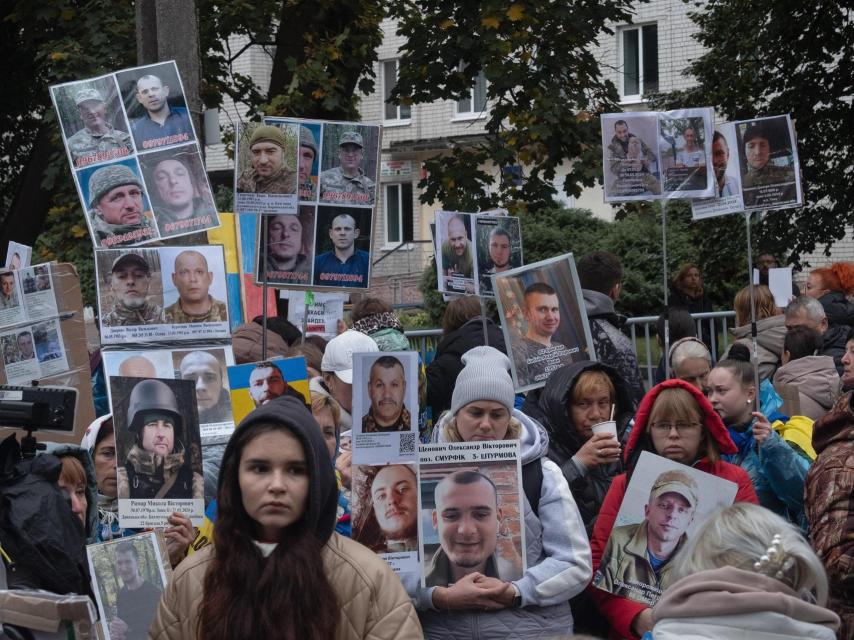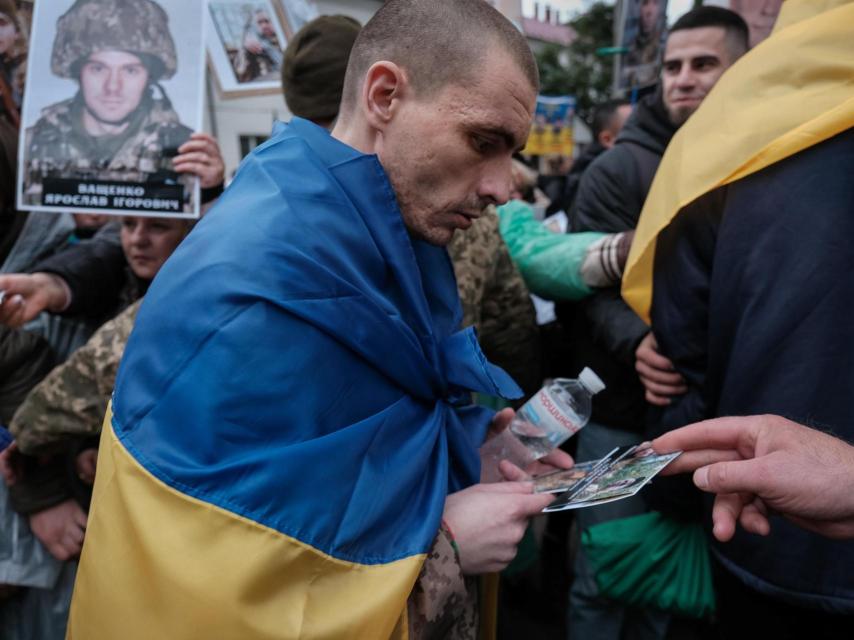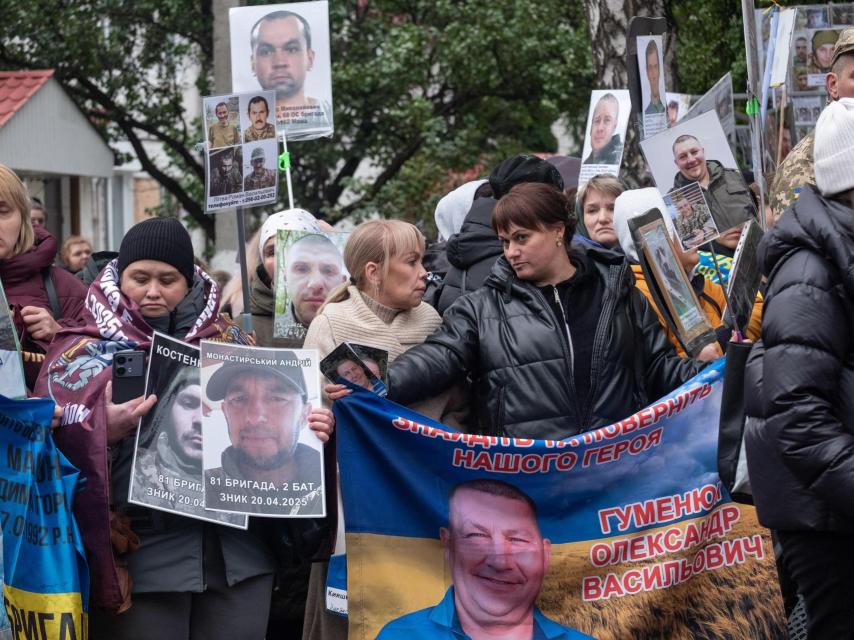They are the ones who wait with a photograph in their hands at each prisoner of war exchange: they hug it to their chest until the soldiers who have just been liberated arrive, and then they raise their arms to show it to them while shouting their names, in the hope that one of them will recognize them.
They are the families of those missing in combat and most do not know if their children, their parents, their husbands are alive or dead.
They don’t mind spending hours standing in the fall rain, under the winter ice, or under the scorching summer sun. Every time there is an exchange of prisoners – and there have been more than 60 since the war began – hundreds of relatives travel to the hospital where they receive the Ukrainians returning from captivity.
These recently released people are almost their only hope of getting proof of life, some information about the whereabouts of their loved ones. And when the miracle occurs, when some of them recognize the faces that are in those portraits – although most have lost so many kilos during captivity that it is difficult to recognize them – they restore hope to all of Ukraine.
A young Ukrainian woman goes to a prisoner of war exchange seeking information about her fiancé, who has disappeared in combat.
The Spanish
“I have in my hands the photo of my son, his name is Oleksander. He is a veterinarian, but he enlisted in the first days of the invasion and served as a combat doctor in the Army’s 30th Brigade,” he says. Ivana 73-year-old man, who clings to his son’s portrait as he speaks.
“He disappeared in May 2023, when the group’s mercenaries Wagner They entered the city Bajmut. His companions saw him for the last time in combat positions, and after that we had no more news.” The serenity with which this father speaks, who refuses to lose hope, contrasts with his eyes full of tears.
“We hope he is alive, but we have no confirmation that he is in captivity. The Russians do not give any information. So we come here and give the photos to the boys who have been released,” he continues, while showing a bag full of copies of his son’s photograph. “I hope someone recognizes it.”

Relatives of Ukrainian prisoners of war and missing in action attend an exchange seeking information about their loved ones and showing their portraits.
The Spanish
badminton rackets
Other mothers approach Ivan during the interview. They also want to talk about their children, explain where they disappeared and show their photographs. They all embrace portraits; Some have made banners with them and others have even screen-printed them on flags that they wrap around their shoulders.
They have invented all kinds of homemade systems to display these photographs and to be able to raise them above their heads so that the arriving soldiers can see them in the crowd. Some mothers carry a kind of selfie stick, others have stuck their portraits on badminton rackets. They also place them on the facade of the hospital. Everywhere you look you can see the look of a Ukrainian soldier.
“I have a second-degree disability, and when parents are disabled, their children are not obliged to go to the Army,” he explains. Ivan. “When the war started I asked Oleksander: ‘Son, shall I prepare my disability papers?’ And he said yes to reassure me, but then he got ready and said: ‘If all of us write those petitions and stay at home waiting for them to arrive, there will be no future for Ukraine. And I don’t want that for my children.’”
“You know, there is not a day, not a minute, not a second in which we do not think about them. I and all these people have a common suffering,” he continues Ivan. “We support each other, also psychologically. But what you see here is suffering, a lot of suffering. In each of those who are here… it is a very great tragedy.”
Some screams stop the interview: three women hug each other, cry and jump while trying to type on their phones with trembling hands. They have just been confirmed that their children are among the prisoners they have released, and they want to immediately call the entire family.
They will be able to hug them in a few hours; They haven’t seen them for 1,317 days. The three were taken prisoner at the beginning of the invasion, at the nuclear power plant in Chernobyl: “They had to surrender so that the Russians would not open fire on the atomic plant facilities. They prevented the catastrophe from being repeated,” says one of the mothers.

A recently released Ukrainian prisoner of war collects portraits given to him by the families of other captive or missing soldiers, who hope he recognizes someone.
The Spanish
Those who return
“I remember the screams of the people and then I saw my wife, and we hugged… I don’t remember much else,” he says. Eugenioa former prisoner of war who was released two months ago and has attended the exchange to support his companions.
In this latest prisoner exchange, which took place on Friday, 185 Ukrainians – including 20 civilians – returned home. Before arriving in Ukraine, they all travel by bus from the prisons of the Russian Federation or from the penal colonies that the troops of Vladimir Putin have built in the occupied territories of the Donbás.
They are taken by road to Belarusand there, next to the border with Ukraine, the exchange takes place: 185 Ukrainians for 185 Russian captives. There are no families in that place, only representatives of both armies.
When they cross the border, everyone gets rid of the clothes they were wearing on the Russian side. They burn it right there, while they put on a new one that is given to them. Afterwards, they board other buses and leave for the city of Chernihivwhere all those families wait.
It is not easy for a recently released person to recognize faces among the hundreds of photos they are shown. They arrive stunned, like Eugenio; some have been held captive for more than three years and all have been tortured by the Russians during that time. But the doctors who assist them and the soldiers who accompany them collect all the portraits so that they can review them when they are calmer. Everyone wants to help the families who continue to wait.
Since the large-scale invasion began, more than 7,000 Ukrainians have returned from Russian captivity, but there are tens of thousands of missing people – an estimated 55,000 – for whom their families are still waiting without knowing whether they are in a Russian prison or a morgue.

Relatives of Ukrainian prisoners of war and missing in action attend an exchange seeking information about their loved ones.
The Spanish
not knowing anything
Corpses – both Ukrainian and Russian – are also part of some exchanges. Returning them to their families is very important from a psychological point of view: it allows them to close a chapter, regain a little peace to continue with their lives.
The Kremlin – violating international law – does not provide a list of the names of the Ukrainian prisoners of war in its possession. But it also does not provide data on those killed in combat whose bodies have been left on the Russian side. And, since there is no confirmation of death, families cling to the hope that they are still alive.
A hope that, in most cases, is eating them up inside. It is another form of psychological torture that Putin inflicts on the Ukrainian people to try to break them. And desperation is seen in the eyes of those who come – irreducible – to each of these exchanges.
Despite the infinite pain, the dignity with which all these fathers and mothers, wives and even grandmothers wait for the prisoners of war – with photographs of their loved ones in their hands – is a reflection of the resilience of the Ukrainian people.
Some travel hundreds of kilometers to get there, and most return empty-handed. When they see the reunion of the luckiest ones, they are happy for them, but, at the same time, they ask themselves: “Why wasn’t it me? Why hasn’t he returned? Why hasn’t anyone recognized him?”
the son of Ivan, Oleksanderwas 46 years old when he disappeared in Bajmut. A few months later their third child was born. “It’s just like him, his same eyes,” says the grandfather through tears. “Every morning, when he gets up, he goes to kiss his father’s photo. We can’t stop thinking about him for even a minute, even if we want to.”
“Our people do not deserve so much suffering,” adds this father. “We lived peacefully, without harming anyone, but ‘the older brother’ came to free us… from life.”
The post “We don’t know if they are alive or not” appeared first on Veritas News.
